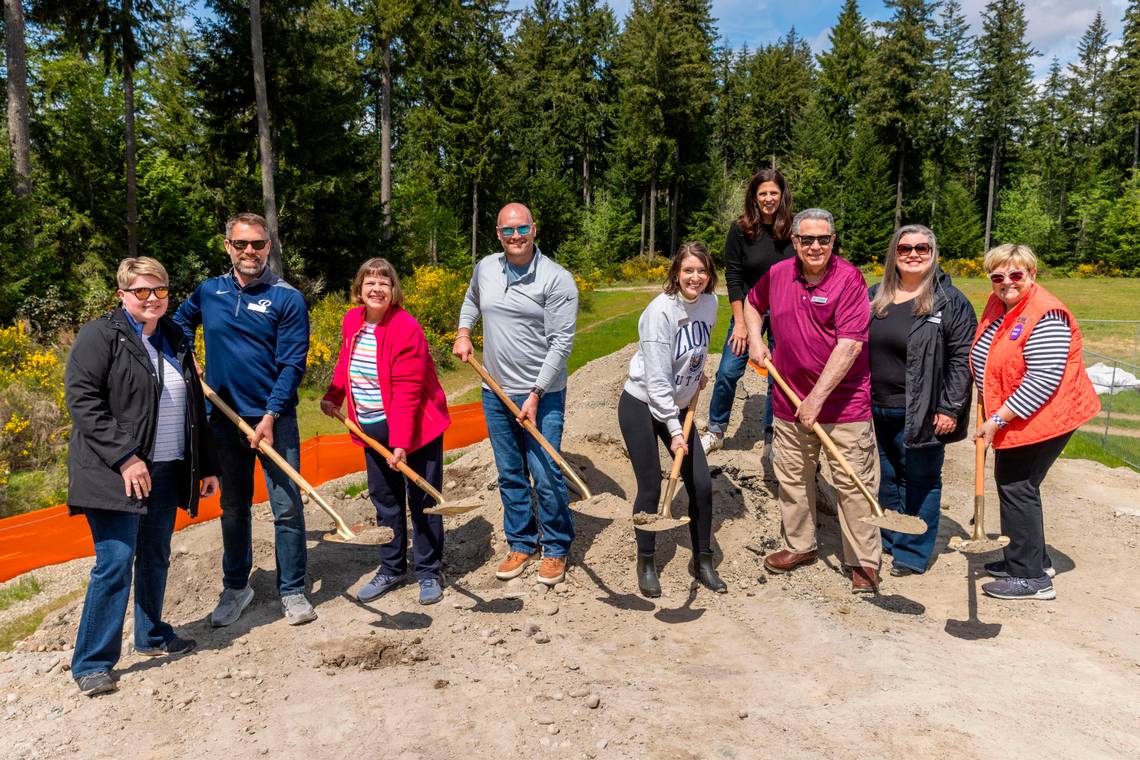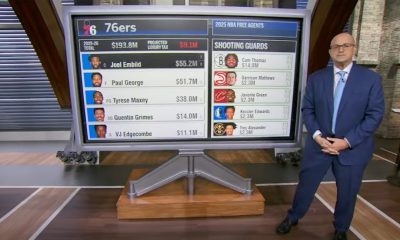WEST SACRAMENTO, Calif. (AP) — Those chants of “sell the team” that rang from every corner of the Coliseum during the Athletics’ final seasons in Oakland are noticeably less obvious these days as the club plays the first of three scheduled years at a Triple-A ballpark in California’s capital region.
Not that all the negative feelings have been cast aside. There is still plenty of ill will toward the team that moved some 90 miles north.
During a recent Braves-A’s series, two supporters showed up in “Forever Oakland” T-shirts, while another fan from Fresno arrived at Sutter Health Park wearing a “Rooted in Oakland” shirt.
It’s a drastically different scene from the A’s old Oakland home.
Fans staged “reverse boycott” protests where they packed the Coliseum, brought homemade signs begging the team to stay and loudly called for owner John Fisher to “SELL!” In Sacramento, there’s a pervading sense the A’s are a rental, not a long-term investment. As soon as 2028, they plan to move into a what has been valued as a $1.75 billion ballpark on the Las Vegas Strip. Construction began last month.
While many A’s fans moved on and want nothing to do with the team, some still drive long distances to games in Sacramento and try to make the best of the situation — a big league team in a small-time stadium.
“It’s a big difference walking (through the ballpark) in about five minutes instead of walking the Coliseum in like 20, 30 minutes,” said Francisco Almazan from Modesto.
It’s not a wholly comfortable setup for players and coaches. The A’s built a two-story clubhouse beyond left field that on the top floor includes a lounge, kitchen and offices for manager Mark Kotsay and his coaches. The players’ lockers are on the first level.
“Everybody is trying to make the best of it,” outfielder Lawrence Butler said. “I’m just thankful for them trying to make it up to big-league standard.”
Major League Baseball Commissioner Rob Manfred acknowledged while speaking at the All-Star Game that playing in a 10,000-seat ballpark isn’t perfect. He said the circumstances would be different if the A’s moved directly into a 33,000-capacity facility like the one underway in Las Vegas.
Union chief Tony Clark was less diplomatic, insisting players prefer to work in an actual big league ballpark.
“There’s still a little bit of hope that something may come to fruition before 2028 and what’s being described as the time where the new ballpark will be in place,” Clark said. “But we’ll have to see.”
A’s players know the situation: The plan is to play in America’s party capital less than three years from now, but that seemingly far-off timeline doesn’t consume their day-to-day baseball lives.
“I think this group is focused on what they need to be focused on,” Kotsay said. “They come to prepare every day. You walk through our locker room, there’s a consistent routine and consistent work ethic that goes on prior to them playing the game.”
Still, as much as they try to stay in the moment, the A’s are very much tied to their past, present and future with three far different cities.
Oakland is embracing the B’s, and the Coliseum has a new tenant
Some baseball fans in the A’s old market have shifted their interest to the Oakland Ballers. The “B’s” have been a huge hit at intimate Raimondi Park — capacity around 4,000 — complete with mascot Scrappy the Rally Possum and nostalgic nods to Oakland at every turn.
The B’s have provided a big lift for a city that watched the NBA’s Golden State Warriors move to San Francisco in 2019 and the NFL’s Raiders leave for Las Vegas the next year.
Last month, the Ballers unveiled a mural honoring late Hall of Famer Rickey Henderson, who died in December at age 65.
The Oakland Roots soccer team now plays its home games at the Coliseum, where cricket has also become a popular choice given the dual-sport facility’s size.
Some longtime employees now work Roots games but many moved on or retired, unwilling to make the trek to Sacramento — though most weren’t invited.
Las Vegas prepares to welcome an MLB franchise
A formal groundbreaking on the new ballpark occurred June 23, with Fisher, Manfred and Nevada Gov. Joe Lombardo among those speaking at the festivities. There is a tight window for the venue to be ready by opening day in 2028.
The A’s hope to complete the project in 2027. They launched a construction cam so fans can track the progress, and without a doubt, the team will be under a microscope trying to meet its ambitious deadline.
Then the question becomes: Will Las Vegas embrace the A’s?
Las Vegas’ strong support for its first major professional team, the NHL’s Golden Knights, helped pave the way for what has become an explosion of sports in a city once shunned because of legalized sports betting. The Raiders draw large crowds, but many game days feel like neutral sites with opposing fans showing up by the thousands. The Aces became the first WNBA team to sell out an entire season — and did so twice.
Longtime A’s radio play-by-play man Ken Korach has a unique perspective on it. In his 30th season calling A’s games, Korach moved to the Henderson, Nevada, suburb in 1992 and has stayed put. He figured MLB might explore the market, either through relocation or expansion.
“There are a lot of conflicting emotions there,” Korach said. “I’ve always felt the Bay Area is a two-team market, and I’ve always felt that Vegas could support a major-league team.”
Rookie infielder Max Muncy, too, can already weigh in on the A’s current home and their future one. He has played 81 games in Las Vegas over the past two seasons, but began this season in Sacramento and returned to the big club before going on the 10-day injured list Tuesday after taking a pitch to his right hand.
“I had a great time in Las Vegas,” Muncy said. “Those fans are great. The atmosphere is great. It’s a great city. I enjoyed living there. I think it’s going to be a special place to play, as it is here. I really enjoyed my time there, and I think a lot of guys that played there will say the same thing.”
Being on the Strip would allow the A’s to attract tourists given the ballpark is walking distance for many visitors. That could be especially important for non-marquee, weeknight matchups in contrast to in-demand weekend series against big-market teams like the Yankees or Dodgers.
The club has begun trying to establish a foothold in the community. The A’s said they have contributed $1.5 million since 2023, including more than $400,000 this year, to nonprofits and other similar organizations that include every youth baseball and softball team. They have been involved in more than 30 events this year from youth sports to festivals to public watch parties with more planned through the end of 2025.
Sacramento is trying to enjoy the A’s while they’re still around
Robert Greenberg, an A’s fan who lives in Fresno, isn’t sure he will keep rooting for the green and gold if and when they move for good even if it’s an easier drive to Sacramento than to Oakland. He believes Fisher cut payroll and undermined the team to suppress attendance and facilitate its move.
“I guess he got what he wanted,” Greenberg said.
Ayad Bunni of San Mateo said he was a fan before hosting the “Locked on A’s” podcast. He considered not following the A’s and understands why many others no longer cheer them on, but said he didn’t fault the club for taking these steps.
“As an A’s fan and being from here, would I love for them to be in Oakland?” he said. “Absolutely, 100%.”
The A’s average 9,782 fans, and they and Tampa Bay — also playing in a Triple-A ballpark this season after Tropicana Field was damaged by a hurricane — are the only teams were fewer than 10,000 per game. The Athletics averaged 11,386 fans last season in the Coliseum, lowest in MLB.
Meanwhile, the players play on, and whether the process turns out to be one big sinking ship remains to be seen. It also could become a move that puts the organization on the trajectory to future success in the box office and on the field.
But the here and now gives the A’s plenty to think about, and All-Star designated hitter Brent Rooker acknowledged he and his teammates have faced adversity most other clubs haven’t encountered.
“Every challenge you face in this game or outside this game is going to mold you and build you into the person you’re going to ultimately become,” Rooker said. “So anything you can use to your advantage, whether it’s adversity, a challenge, a success, a failure, all those things can be made into positives.”
AP Baseball Writer Janie McCauley in Oakland contributed to this report.
AP MLB: https://apnews.com/hub/MLB























































